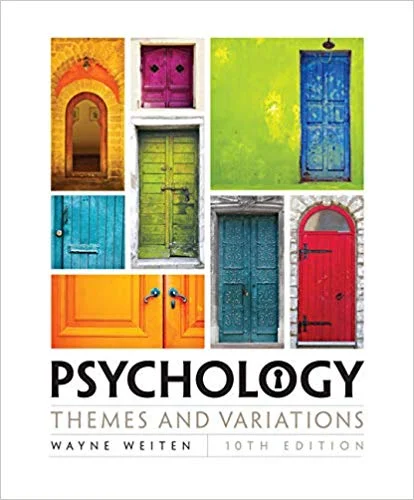Description
Test Bank for Psychology Themes and Variations 10th Edition by Weiten
Table of Contents
1. The Evolution of Psychology.
2. The Research Enterprise in Psychology.
3. The Biological Bases of Behavior.
4. Sensation and Perception.
5. Variations in Consciousness.
6. Learning.
7. Human Memory.
8. Cognition and Intelligence.
9. Motivation and Emotion.
10. Human Development Across the Life Span.
11. Personality.
12. Social Behavior.
13. Stress, Coping, and Health.
14. Psychological Disorders.
15. Treatment of Psychological Disorders.
Appendix A: Answers to Concept Checks.
Appendix B: Statistical Methods.
Appendix C: Sustainability
Chapter 1 Multiple-Choice Items
MULTIPLE CHOICE
1.Psychology’s intellectual parents are the disciplines of
|
a. |
physics and physiology. |
|
b. |
philosophy and physiology. |
|
c. |
chemistry and physics. |
|
d. |
philosophy and chemistry. |
ANS: B PTS: 1 REF: 1.1 Psychology’s Early History
DIF: Understand
2.The person responsible for establishing psychology as an independent discipline with its own subject matter is
|
a. |
G. Stanley Hall. |
|
b. |
René Descartes. |
|
c. |
William James. |
|
d. |
Wilhelm Wundt. |
ANS: D PTS: 1 REF: 1.1 Psychology’s Early History
DIF: Understand
3.The notion that the subject matter of psychology should be the scientific study of conscious experience is MOST closely linked with
|
a. |
William James. |
|
b. |
Wilhelm Wundt. |
|
c. |
Sigmund Freud. |
|
d. |
John B. Watson. |
ANS: B PTS: 1 REF: 1.1 Psychology’s Early History
TOP: WWW DIF: Understand
4.According to Wilhelm Wundt, the focus of psychology was on the scientific study of
|
a. |
observable behavior. |
|
b. |
conscious experience. |
|
c. |
unconscious motivation. |
|
d. |
the functions of behavior. |
ANS: B PTS: 1 REF: 1.1 Psychology’s Early History
DIF: Understand
5.While the term psychology has existed since at least the early 1700s, psychology did not come to be considered a science until
|
a. |
the 1750s. |
|
b. |
the early 1800s. |
|
c. |
the late 1800s. |
|
d. |
the 1940s. |
ANS: C PTS: 1 REF: 1.1 Psychology’s Early History
DIF: Understand
6.In a discussion with your professor, she tells you that she believes that the focus of psychological study should be to break the conscious experience into its basic elements. Which of the following historical schools of thought is your professor’s idea MOST consistent with?
|
a. |
Behaviorism |
|
b. |
Functionalism |
|
c. |
Structuralism |
|
d. |
Psychoanalysis |
ANS: C PTS: 1 REF: 1.1 Psychology’s Early History
DIF:Apply
7.The school of psychology that focused on identifying and examining the fundamental components of conscious experience, such as sensations, feelings, and images, was
|
a. |
humanism. |
|
b. |
behaviorism. |
|
c. |
structuralism. |
|
d. |
functionalism. |
ANS: C PTS: 1 REF: 1.1 Psychology’s Early History
DIF: Understand
8.If while watching an exquisite sunset you stop and analyze your sensations, thoughts, and feelings, you would be performing introspection as the ____ once did.
|
a. |
structuralists |
|
b. |
behaviorists |
|
c. |
functionalists |
|
d. |
psychoanalysts |
ANS: A PTS: 1 REF: 1.1 Psychology’s Early History
DIF:Apply
9.Isabel is listening to a piece of classical music and tape recording all her feelings and impressions as she experiences them. Isabel is using a technique similar to the research methodology of
|
a. |
structuralism. |
|
b. |
functionalism. |
|
c. |
behaviorism. |
|
d. |
humanism. |
ANS: A PTS: 1 REF: 1.1 Psychology’s Early History
DIF:Apply
10.In an attempt to learn something about his conscious experience, William looked at an abstract painting and wrote down all of his impressions as they came to him. This technique is called
|
a. |
introspection. |
|
b. |
retrospection. |
|
c. |
empiricism. |
|
d. |
psychoanalysis. |
ANS: A PTS: 1 REF: 1.1 Psychology’s Early History
DIF:Apply





Be the first to review “Test Bank for Psychology Themes and Variations 10th Edition by Weiten”